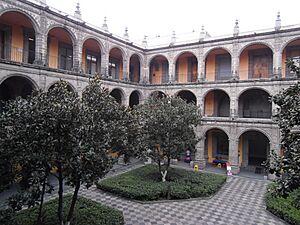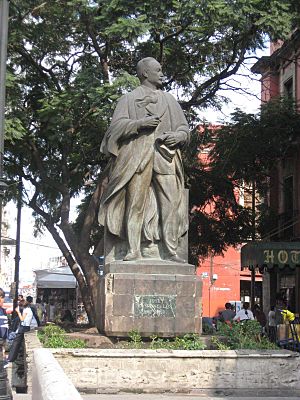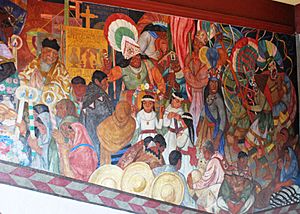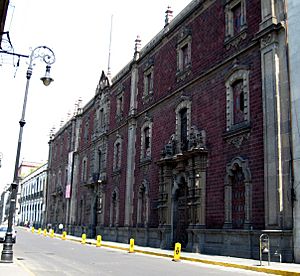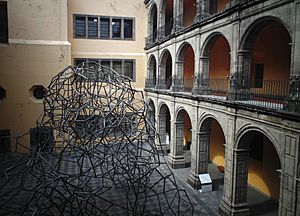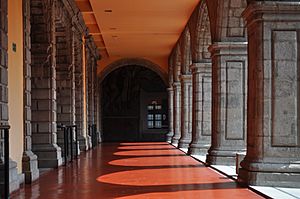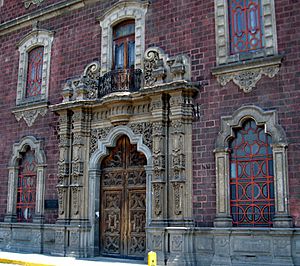Colegio de San Ildefonso facts for kids
| Colegio de San Ildefonso | |
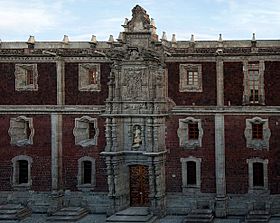
A colonial palace section façade: Colegio Grande
|
|
| Former name | San Ildefonso College Jesuit boarding school |
|---|---|
| Established | 1588 Jesuit boarding school |
| Dissolved | 1978 (became museum) |
| Location | San Ildefonso Street, Mexico City |
| Key holdings | José Clemente Orozco Diego Rivera |
| Birthplace of Mexican muralism | |
The Colegio de San Ildefonso is a famous museum and cultural center in Mexico City. It's known as the starting point for the Mexican muralism art movement.
This historic building began as a respected Jesuit boarding school. Later, it became the National Preparatory School. The school closed in 1978, but the building reopened in 1992 as a museum. Today, it shows off amazing art and historical items. You can also see many murals painted by famous artists like José Clemente Orozco and Diego Rivera. The building is in the historic center of Mexico City.
The college was founded in 1588. It has six main parts. Five parts are old colonial buildings, finished in 1749. These include the Colegio Grande, Colegio Chico, the chapel, El Generalito, and the courtyard of los Pasantes. The sixth part is the modern Bolívar Amphitheater, completed in 1911.
History of San Ildefonso
From Jesuit School to National Preparatory School
The Jesuits, a religious group, came to Mexico in 1572. They started many schools for young people, and San Ildefonso, founded in 1588, was their most important. In 1618, it joined with another college and received a special royal approval.
Even though Jesuits ran the school, it taught more than just religion. It was a place where young men lived and studied. They also took classes at the Royal and Pontifical University of Mexico.
The school grew, so new parts were added between 1712 and 1749. This new section is called the "Colegio Chico" (Small College). The original part is known as the "Colegio Grande" (Large College).
San Ildefonso was very important in the 1700s. But in 1767, the Jesuits were asked to leave all Spanish lands, including Mexico. The school then faced challenges. It was even used to house soldiers during wars.
A New Era: The National Preparatory School
By the 1860s, the old Jesuit school building was in poor condition. In 1867, Benito Juárez changed the education system. He made schools government-run instead of church-run. San Ildefonso became the Escuela Nacional Preparatoria, or National Preparatory School.
This new school prepared students for the National University. It started with over 900 students. In 1929, the Preparatory School became part of the independent university system. During a challenging time for students in 1968, the building was occupied by soldiers. The school closed completely in 1978.
Birthplace of Mexican Muralism
After the Mexican Revolution in the 1920s, the government wanted art to tell Mexico's story. San Ildefonso was one of the first public buildings chosen for these new murals. José Vasconcelos, the Secretary of Education, asked artists to paint.
Famous artists like José Clemente Orozco, Diego Rivera, and Fernando Leal created amazing murals here. These artworks showed Mexico's history and culture.
San Ildefonso as a Cultural Center Today
The building stayed closed after 1978 until 1992. It was then renovated for a big art show. In 1994, it opened permanently as a cultural center and museum.
Today, the museum hosts temporary art and history exhibits from Mexico and other countries. It also helps bring life back to Mexico City's historic center. The museum has a gift shop with unique items and publications.
Exploring San Ildefonso
The San Ildefonso Street Facade
The long front of the building on San Ildefonso Street is the original design. It's made of red volcanic stone called tezontle. The windows and doors are framed with grayish-white stone.
There are two large, fancy doorways. One leads to the Colegio Chico, the oldest part of the facade. It has special designs called estipite pilasters. The other doorway leads to the Colegio Grande. It features reliefs of Saint Joseph and Our Lady of the Rosary.
The Colegio Grande
The Colegio Grande (Large College) is the biggest and original part of the complex. It has a large courtyard surrounded by arches, hallways, and rooms. There's also a smaller courtyard called the "Patio de los Pasantes."
This part of the school has three floors and a grand staircase. Most of the famous murals by José Clemente Orozco are here, painted between 1922 and 1927.
In the entrance area, you can see a mural by Ramón Alva de la Canal called The Spanish Landing and Planting of the Cross on New Land. It was painted in 1922 and shows an important moment in Mexican history. On the opposite wall is Allegory of the Virgin of Guadalupe by Fermin Revueltas.
On the second floor, Orozco's murals include The Old Order and The Trench, which is considered one of his best works. On the third floor, you'll find his series called New Ideals.
The main staircase also features Orozco's The Origin of Spanish America. Other artists contributed too. On the southern wall, French artist Jean Charlot painted The Conquest of Tenochtitlan, showing Aztec history. The northern wall has Fernando Leal's The Festivities of the Lord of Chalma, known for its bright colors.
The Chapel and El Generalito
The old chapel is next to a hallway. It was used as a library when the building was a preparatory school. It still holds several paintings.
"El Generalito" (the little general) is the main assembly room. It got its name because it was used for all important meetings, even though it's small. This room has beautifully carved wooden choir stalls from the 1600s.
Patio de los Pasantes and Colegio Chico
The "Patio de los Pasantes" (Courtyard of the Graduates) is a smaller courtyard in the Colegio Grande. Students who had finished their classes but were writing their final papers stayed here.
The Colegio Chico (Small College) was added in the 1700s. It has a simple stairwell. The muralist Siqueiros started painting this stairwell between 1922 and 1924, but much of his work was lost. Only The Elements on the ceiling remains.
The Bolívar Amphitheater
The main entrance to the museum is now on Justo Sierra Street, through the Simón Bolívar Amphitheater. This amphitheater was built between 1906 and 1911. It was designed to look like the old Baroque style of the rest of the complex.
The lobby has fancy decorations. On the left, there's a fresco by Fernando Leal called Epopeya bolivariana. It shows heroes who fought for independence in the Americas.
Inside the Bolívar Amphitheater, you can see one of Diego Rivera's early murals, The Creation. This mural shows some of Rivera's unique artistic style, like curved human figures and Mexican themes.
Notable alumni
- José Joaquin Jimeno (1804-1856), missionary
See also
 In Spanish: Antiguo Colegio de San Ildefonso para niños
In Spanish: Antiguo Colegio de San Ildefonso para niños
- List of Jesuit sites


